<% ns_puts [mkm_getnavbar] %>

The Myth of the Back Foot
by John Yandell
Still Photos by J Gregory Swendsen
|
The fact is virtually no pro player steps into the serve, and the same is true of good servers at every level. The step with the back foot is a myth.
If good servers don’t step through the motion, what do they do? They all land in the court on the front foot. Rather than moving the back foot forward, they do the opposite.
Good servers actually kick the back leg backward in the opposite direction of the serve. The back leg usually reaches a position where the calf or even the upper leg is actually horizontal, or parallel, to the court surface.
So the real pattern is forward with the front foot, and backward with the back. If you’re skeptical, don’t take my word for it—just watch any TV match and you’ll see exactly what I am talking about it.
Or go to ProStrokes Gallery and pull up any serve. Pay particular attention to the section on Leg Action. You’ll see the players all land on the front foot with the back leg kicking backward. It’s the same for the women as the men.
Why? This pattern of leg action is a direct result of the deep knee bend which is universal on the serve in the modern game. Watch a player like Pete. His knee bend is phenomenal. At the deepest part of the bend, his upper leg or thigh is at an angle of about 30 degrees to the court.
|
Andre Agassi has at least as much leg action as Pete. He has one of
the most underrated serves in tennis, and he also has one of the deepest
knee bends.
Both Pete and Andre coil the legs, primarily the quadriceps, which are the
strongest muscles in the body, through their incredible knee bend. This
stores tremendous energy in the leg muscles. As the legs uncoil this
energy is naturally released. This in turn propels the players upward and
into the air toward the ball.
Watch how the body natural explodes upward to the ball with the energy
passing from the legs to the torso. The body is in line with itself and
moving upward toward the ball as a unit. The natural landing from this
trajectory is on the front foot.
The kick back is critical to a balanced landing. In this respect, the back
leg serves as a counterweight. It’s backward movement counter balances the
thrust forward and upward. Usually the leg kicks backward at about a 30 or
45 degree angle.
This allows the players to land on balance on the front foot and keep the
torso relatively upright. Without the back leg kick, most servers would
probably have a hard time stopping themselves from falling over.
It is important to note that this thrust with the legs is not a “jump” or
a “leap.” Many top pros could undoubtedly produce a vertical leap somewhat
comparable to basketball players, that is of 2 feet or more. This is not
what we see in the leg action of the modern serve. Pro players are in the
air at the hit, but only a few inches above the court.
There is no deliberate attempt to jump. Leaving the court is a natural
consequence of the uncoiling of the legs from the knee bend. It is
generated automatically as part of the bio-mechanical chain of the service
motion.
The footwork pattern is actually more like a “hop” than a jump. As the legs uncoil, the player hops forward a few inches into the air landing inside the court on the front foot.
|
|
|
|
|
|
The front foot landing is universal. Top young servers like Dent and Roddick land on the front foot, as do players who use the “pinpoint” stance such as Kuerton and Hewitt. |
|
This pattern of “coil and hop” is virtually universal in pro tennis for both men and woman. Over the last 5 years I’ve filmed dozens of pro players
using high speed digital video (www.AdvancedTennis.com). Only one player
used the step with the back foot (Petr Korda, now off the tour.)
We see the same footwork pattern in the young players with huge serves
like Andy Roddick and Taylor Dent. We also see it in players who drag
their back foot up close behind the front foot at the start of the motion,
players including Lleyton Hewitt, Mark Philippoussis, Gustavo Kuerten, and
Greg Rusedski
This additional step forward with the back foot creates what is referred to as a “Pinpoint” stance.
But players who use the “Pinpoint,” have the same leg action after the hit as
players like Sampras and Agassi. None of them step into the serve with the
back foot. They all land on the front foot and kick the back leg back in a
virtually identical pattern.
(In my next article I’ll go into a more detailed analysis of the “Pinpoint
Stance” including an examination of it’s alleged advantages.)
This use of the knee bend and leg action on the serve is one of the most
obvious technical similarities among all pro players.
It’s also one of the easiest for the average player to emulate. Almost any player from the 3.0 level on up can learn to use his legs like the pros to develop more power, spin, and consistency. Most players can do this fairly quickly and without any other major changes in the motion.
Given the mania club players have about copying the pros, it amazes me how little this simple pro leg action is understood, talked about in coaching and teaching, or consciously emulated by players.
Unfortunately, the myth of the step with the back foot is still extremely
common in teaching and coaching at all levels. This myth is keeping many
players from developing their natural power and reaching their serving
potential.
I recently did a video analysis clinic on the serve at a large tennis club
in San Francisco. Only 2 out of 30 people in the clinic had the right
footwork pattern.
Most of the players in the clinic were serious club players. Many had been
taking lessons for years. But there they all were furiously trying to step
through the service motion with the back foot.
A few days after the clinic, one of the participants came up to me and
started telling me how much better he was already serving now that he was
landing on the front foot. One of the club pros apparently over heard this
because out of nowhere he confronted me, and he seemed quite agitated.
He started ranting about how big his serve was, how he kept his front foot down and took his first step with the back foot. He wasn’t interested in hearing about our research and high speed filming. When I offered to give him some of the video, he started telling me how he could break boards with his bare hands. It got a little weird.
|
But it was also a little sad, especially when I remembered a girl he had developed, a great kid and a great competitor who played on my high school team. She had struggled with her serve for years, but insisted on keeping that front foot planted like a rock. Every time I tried to work with her on it, she’d gotten really defensive. Suddenly I had an idea where she’d developed that attitude.
We all have the tendency to defend our cherished beliefs, even if they don’t stand up too well to close examination. But why is this particular belief about the back foot so widespread and where did it come from in the first place?
Actually the rationale for the back foot step once made perfect sense. This was before a major rule change in the game that forever altered the bio-mechanics of serving. In the 1940’s and 1950’s, the rules required the server to keep one foot on the ground until after contact with the ball. This drastically limited the amount of knee bend or leg coil a player could use.
The 40’s and 50’s were also the golden age of serve and volley tennis,
with 3 of the 4 majors played on grass. So in the effort to get to the net
faster, players would naturally bring the back foot up, timing the step
with the back foot to come through and into the court after the hit.
If you look at TennisONE Contributing Editor Ed Atkinson’s remarkable
video “Kings of the Court,” you’ll
see all the great champions of that era stepping through with the back
foot: Jack Kramer, Lew Hoad, Pancho Gonzales, Rod Laver. You'll notice
that they
all tend to stand up on the front toe at the hit, rather than using their
legs to propel themselves into the air.
|
Last Updated 5/15/02. To contact us, please email to: webmaster@tennisone.com
TennisONE is a registered trademark of TennisONE and SportsWeb ONE; Copyright 1995. All rights reserved.

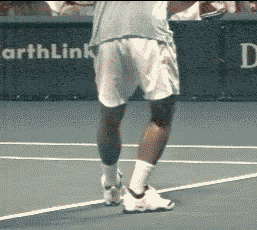
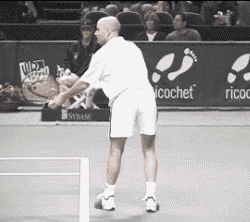
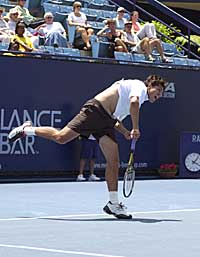
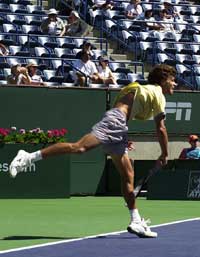
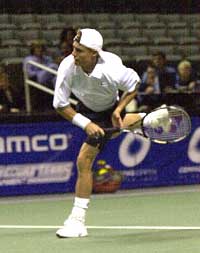
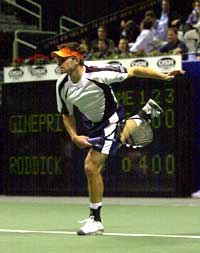
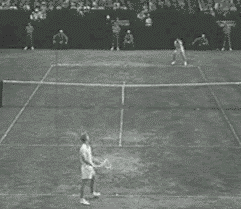
 Visual
Tennis
Visual
Tennis